FY021 Business Studies Report: Collaborative Working and Finance
VerifiedAdded on 2022/12/30
|8
|2115
|1
Report
AI Summary
This report provides an in-depth analysis of the roles of Human Resources (HR), Marketing, and Finance departments within an organization, specifically referencing Sainsbury. It explores how these departments contribute to achieving organizational goals and objectives, highlighting their interlinked nature. The report then examines collaborative working practices, detailing various approaches such as joint ventures and mergers, and their benefits, including increased creativity, efficiency, and learning opportunities, with the Sainsbury-Argos collaboration as an example. Finally, the report delves into the role of financial management, covering its functions such as financial planning, decision-making, and risk assessment, emphasizing the significance of financial reporting within the organization. The conclusion summarizes the key findings, reinforcing the relevance of each department and the importance of collaborative practices and effective financial management for organizational success.
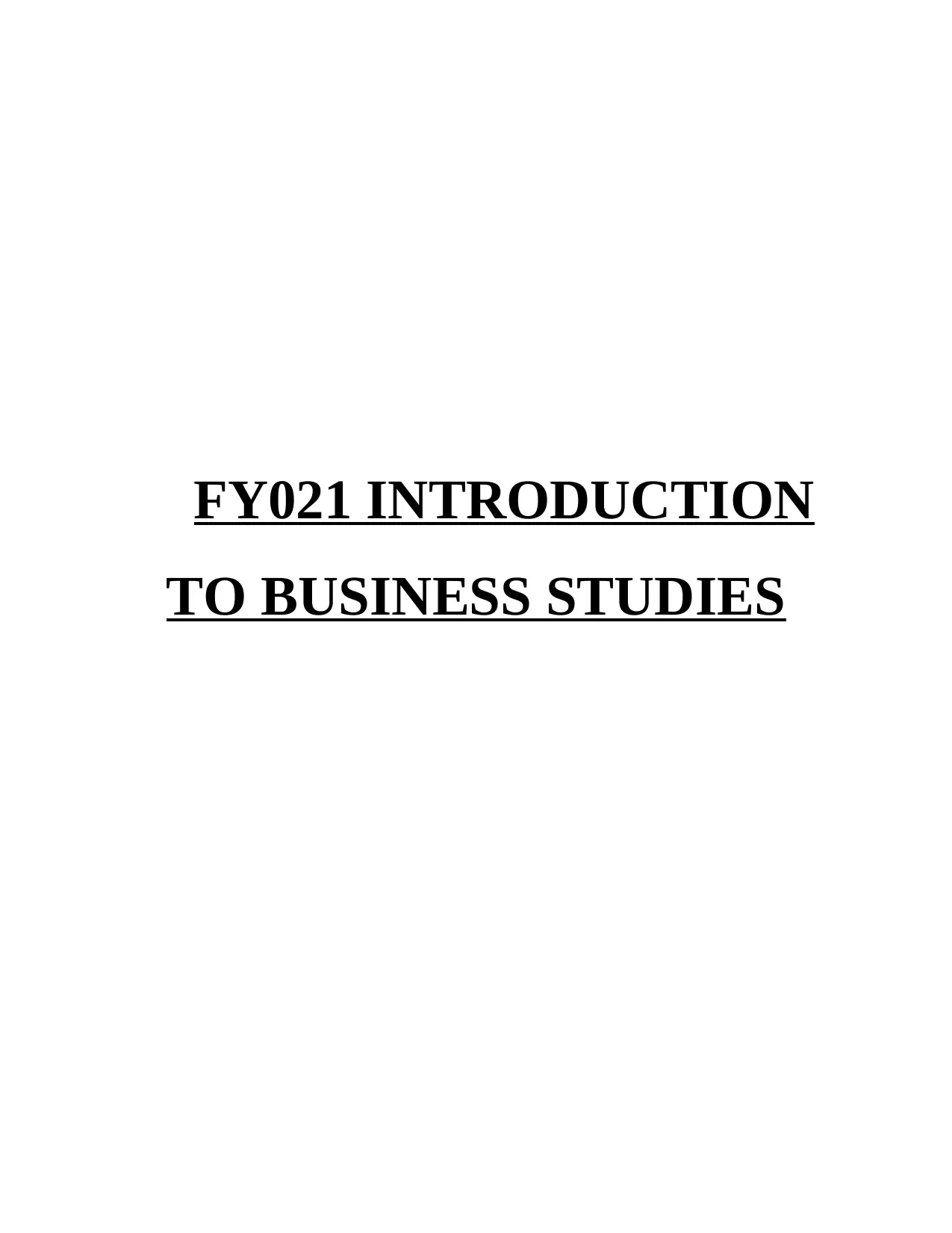
FY021 INTRODUCTION
TO BUSINESS STUDIES
TO BUSINESS STUDIES
Paraphrase This Document
Need a fresh take? Get an instant paraphrase of this document with our AI Paraphraser
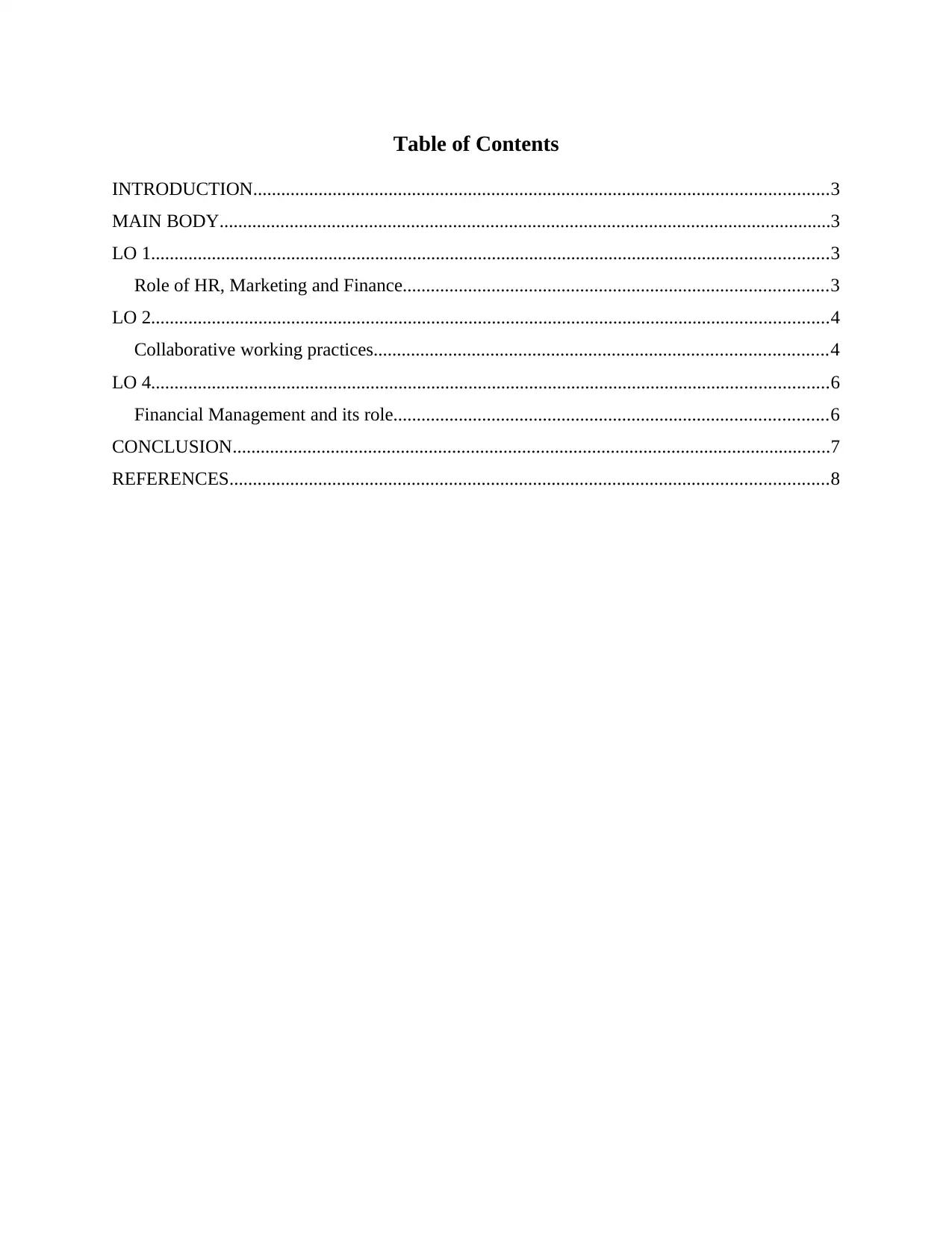
Table of Contents
INTRODUCTION...........................................................................................................................3
MAIN BODY...................................................................................................................................3
LO 1.................................................................................................................................................3
Role of HR, Marketing and Finance...........................................................................................3
LO 2.................................................................................................................................................4
Collaborative working practices.................................................................................................4
LO 4.................................................................................................................................................6
Financial Management and its role.............................................................................................6
CONCLUSION................................................................................................................................7
REFERENCES................................................................................................................................8
INTRODUCTION...........................................................................................................................3
MAIN BODY...................................................................................................................................3
LO 1.................................................................................................................................................3
Role of HR, Marketing and Finance...........................................................................................3
LO 2.................................................................................................................................................4
Collaborative working practices.................................................................................................4
LO 4.................................................................................................................................................6
Financial Management and its role.............................................................................................6
CONCLUSION................................................................................................................................7
REFERENCES................................................................................................................................8
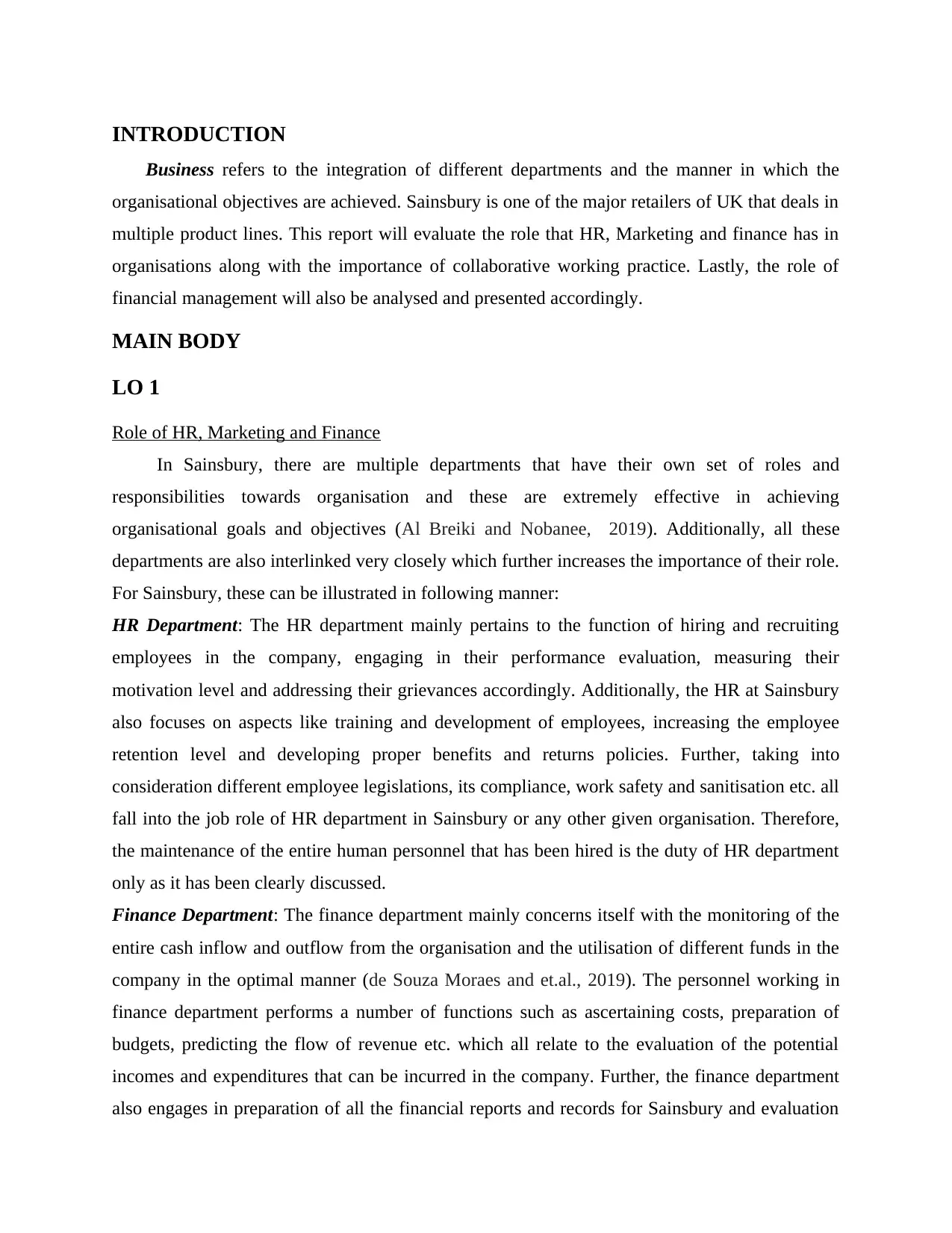
INTRODUCTION
Business refers to the integration of different departments and the manner in which the
organisational objectives are achieved. Sainsbury is one of the major retailers of UK that deals in
multiple product lines. This report will evaluate the role that HR, Marketing and finance has in
organisations along with the importance of collaborative working practice. Lastly, the role of
financial management will also be analysed and presented accordingly.
MAIN BODY
LO 1
Role of HR, Marketing and Finance
In Sainsbury, there are multiple departments that have their own set of roles and
responsibilities towards organisation and these are extremely effective in achieving
organisational goals and objectives (Al Breiki and Nobanee, 2019). Additionally, all these
departments are also interlinked very closely which further increases the importance of their role.
For Sainsbury, these can be illustrated in following manner:
HR Department: The HR department mainly pertains to the function of hiring and recruiting
employees in the company, engaging in their performance evaluation, measuring their
motivation level and addressing their grievances accordingly. Additionally, the HR at Sainsbury
also focuses on aspects like training and development of employees, increasing the employee
retention level and developing proper benefits and returns policies. Further, taking into
consideration different employee legislations, its compliance, work safety and sanitisation etc. all
fall into the job role of HR department in Sainsbury or any other given organisation. Therefore,
the maintenance of the entire human personnel that has been hired is the duty of HR department
only as it has been clearly discussed.
Finance Department: The finance department mainly concerns itself with the monitoring of the
entire cash inflow and outflow from the organisation and the utilisation of different funds in the
company in the optimal manner (de Souza Moraes and et.al., 2019). The personnel working in
finance department performs a number of functions such as ascertaining costs, preparation of
budgets, predicting the flow of revenue etc. which all relate to the evaluation of the potential
incomes and expenditures that can be incurred in the company. Further, the finance department
also engages in preparation of all the financial reports and records for Sainsbury and evaluation
Business refers to the integration of different departments and the manner in which the
organisational objectives are achieved. Sainsbury is one of the major retailers of UK that deals in
multiple product lines. This report will evaluate the role that HR, Marketing and finance has in
organisations along with the importance of collaborative working practice. Lastly, the role of
financial management will also be analysed and presented accordingly.
MAIN BODY
LO 1
Role of HR, Marketing and Finance
In Sainsbury, there are multiple departments that have their own set of roles and
responsibilities towards organisation and these are extremely effective in achieving
organisational goals and objectives (Al Breiki and Nobanee, 2019). Additionally, all these
departments are also interlinked very closely which further increases the importance of their role.
For Sainsbury, these can be illustrated in following manner:
HR Department: The HR department mainly pertains to the function of hiring and recruiting
employees in the company, engaging in their performance evaluation, measuring their
motivation level and addressing their grievances accordingly. Additionally, the HR at Sainsbury
also focuses on aspects like training and development of employees, increasing the employee
retention level and developing proper benefits and returns policies. Further, taking into
consideration different employee legislations, its compliance, work safety and sanitisation etc. all
fall into the job role of HR department in Sainsbury or any other given organisation. Therefore,
the maintenance of the entire human personnel that has been hired is the duty of HR department
only as it has been clearly discussed.
Finance Department: The finance department mainly concerns itself with the monitoring of the
entire cash inflow and outflow from the organisation and the utilisation of different funds in the
company in the optimal manner (de Souza Moraes and et.al., 2019). The personnel working in
finance department performs a number of functions such as ascertaining costs, preparation of
budgets, predicting the flow of revenue etc. which all relate to the evaluation of the potential
incomes and expenditures that can be incurred in the company. Further, the finance department
also engages in preparation of all the financial reports and records for Sainsbury and evaluation
⊘ This is a preview!⊘
Do you want full access?
Subscribe today to unlock all pages.

Trusted by 1+ million students worldwide
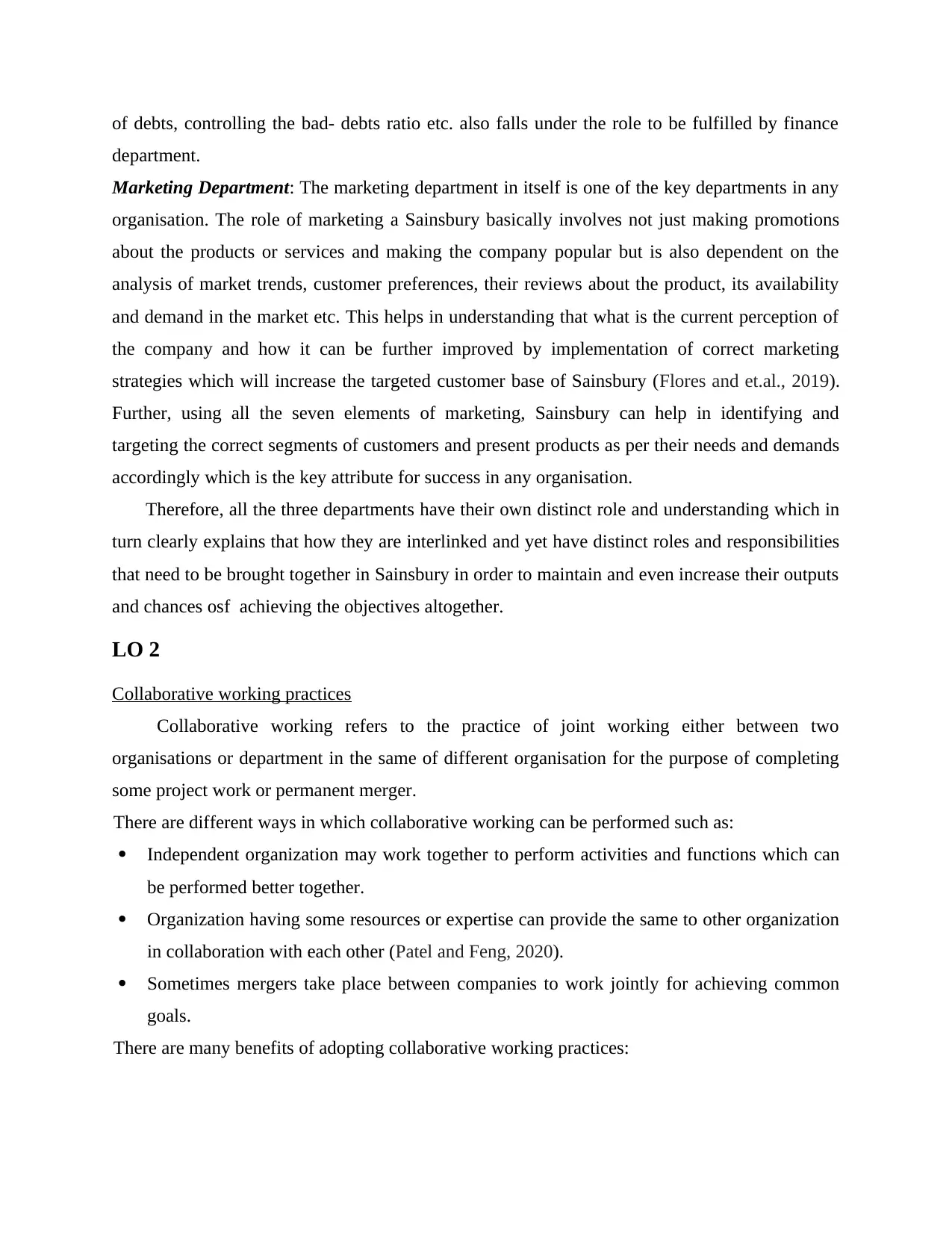
of debts, controlling the bad- debts ratio etc. also falls under the role to be fulfilled by finance
department.
Marketing Department: The marketing department in itself is one of the key departments in any
organisation. The role of marketing a Sainsbury basically involves not just making promotions
about the products or services and making the company popular but is also dependent on the
analysis of market trends, customer preferences, their reviews about the product, its availability
and demand in the market etc. This helps in understanding that what is the current perception of
the company and how it can be further improved by implementation of correct marketing
strategies which will increase the targeted customer base of Sainsbury (Flores and et.al., 2019).
Further, using all the seven elements of marketing, Sainsbury can help in identifying and
targeting the correct segments of customers and present products as per their needs and demands
accordingly which is the key attribute for success in any organisation.
Therefore, all the three departments have their own distinct role and understanding which in
turn clearly explains that how they are interlinked and yet have distinct roles and responsibilities
that need to be brought together in Sainsbury in order to maintain and even increase their outputs
and chances osf achieving the objectives altogether.
LO 2
Collaborative working practices
Collaborative working refers to the practice of joint working either between two
organisations or department in the same of different organisation for the purpose of completing
some project work or permanent merger.
There are different ways in which collaborative working can be performed such as:
Independent organization may work together to perform activities and functions which can
be performed better together.
Organization having some resources or expertise can provide the same to other organization
in collaboration with each other (Patel and Feng, 2020).
Sometimes mergers take place between companies to work jointly for achieving common
goals.
There are many benefits of adopting collaborative working practices:
department.
Marketing Department: The marketing department in itself is one of the key departments in any
organisation. The role of marketing a Sainsbury basically involves not just making promotions
about the products or services and making the company popular but is also dependent on the
analysis of market trends, customer preferences, their reviews about the product, its availability
and demand in the market etc. This helps in understanding that what is the current perception of
the company and how it can be further improved by implementation of correct marketing
strategies which will increase the targeted customer base of Sainsbury (Flores and et.al., 2019).
Further, using all the seven elements of marketing, Sainsbury can help in identifying and
targeting the correct segments of customers and present products as per their needs and demands
accordingly which is the key attribute for success in any organisation.
Therefore, all the three departments have their own distinct role and understanding which in
turn clearly explains that how they are interlinked and yet have distinct roles and responsibilities
that need to be brought together in Sainsbury in order to maintain and even increase their outputs
and chances osf achieving the objectives altogether.
LO 2
Collaborative working practices
Collaborative working refers to the practice of joint working either between two
organisations or department in the same of different organisation for the purpose of completing
some project work or permanent merger.
There are different ways in which collaborative working can be performed such as:
Independent organization may work together to perform activities and functions which can
be performed better together.
Organization having some resources or expertise can provide the same to other organization
in collaboration with each other (Patel and Feng, 2020).
Sometimes mergers take place between companies to work jointly for achieving common
goals.
There are many benefits of adopting collaborative working practices:
Paraphrase This Document
Need a fresh take? Get an instant paraphrase of this document with our AI Paraphraser
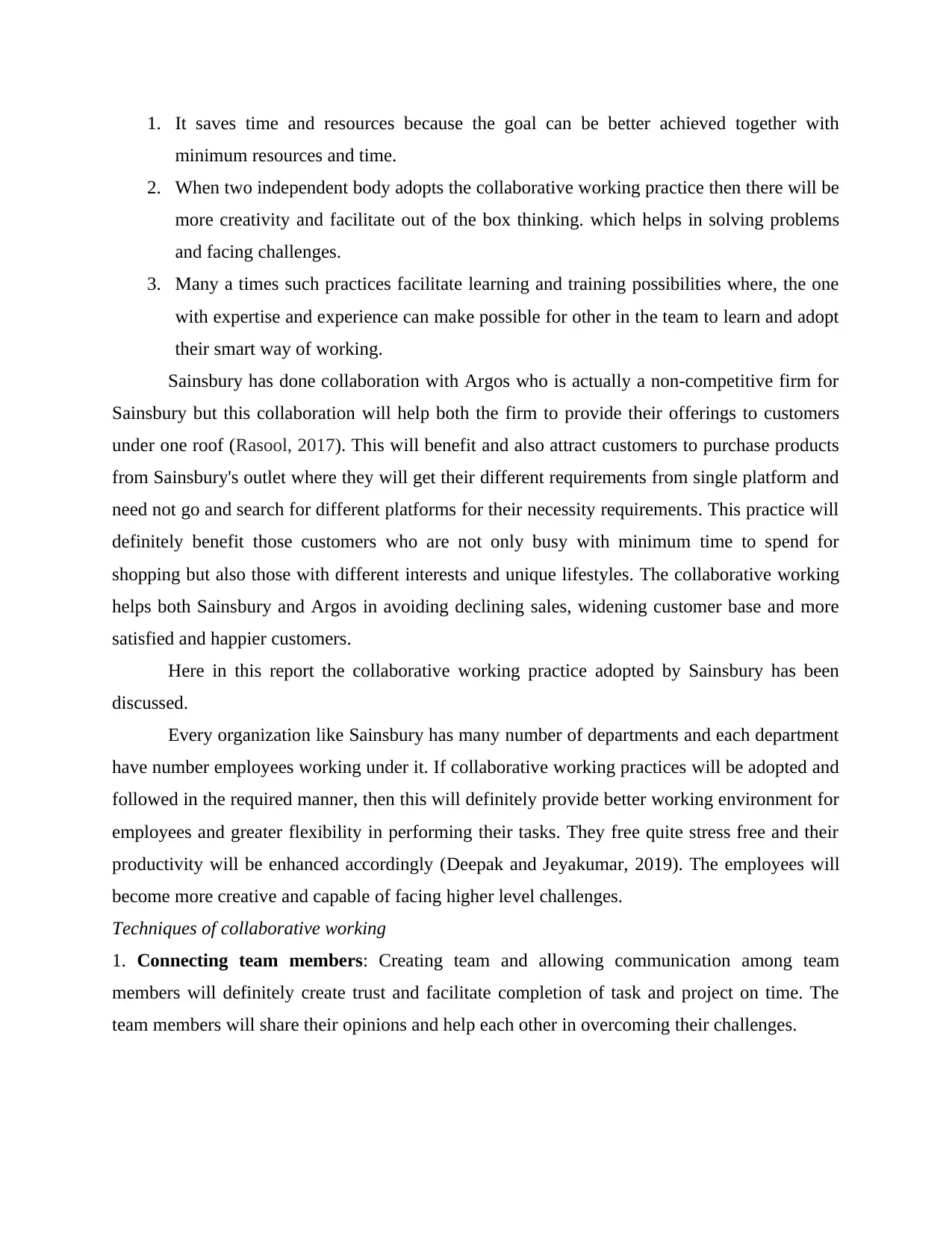
1. It saves time and resources because the goal can be better achieved together with
minimum resources and time.
2. When two independent body adopts the collaborative working practice then there will be
more creativity and facilitate out of the box thinking. which helps in solving problems
and facing challenges.
3. Many a times such practices facilitate learning and training possibilities where, the one
with expertise and experience can make possible for other in the team to learn and adopt
their smart way of working.
Sainsbury has done collaboration with Argos who is actually a non-competitive firm for
Sainsbury but this collaboration will help both the firm to provide their offerings to customers
under one roof (Rasool, 2017). This will benefit and also attract customers to purchase products
from Sainsbury's outlet where they will get their different requirements from single platform and
need not go and search for different platforms for their necessity requirements. This practice will
definitely benefit those customers who are not only busy with minimum time to spend for
shopping but also those with different interests and unique lifestyles. The collaborative working
helps both Sainsbury and Argos in avoiding declining sales, widening customer base and more
satisfied and happier customers.
Here in this report the collaborative working practice adopted by Sainsbury has been
discussed.
Every organization like Sainsbury has many number of departments and each department
have number employees working under it. If collaborative working practices will be adopted and
followed in the required manner, then this will definitely provide better working environment for
employees and greater flexibility in performing their tasks. They free quite stress free and their
productivity will be enhanced accordingly (Deepak and Jeyakumar, 2019). The employees will
become more creative and capable of facing higher level challenges.
Techniques of collaborative working
1. Connecting team members: Creating team and allowing communication among team
members will definitely create trust and facilitate completion of task and project on time. The
team members will share their opinions and help each other in overcoming their challenges.
minimum resources and time.
2. When two independent body adopts the collaborative working practice then there will be
more creativity and facilitate out of the box thinking. which helps in solving problems
and facing challenges.
3. Many a times such practices facilitate learning and training possibilities where, the one
with expertise and experience can make possible for other in the team to learn and adopt
their smart way of working.
Sainsbury has done collaboration with Argos who is actually a non-competitive firm for
Sainsbury but this collaboration will help both the firm to provide their offerings to customers
under one roof (Rasool, 2017). This will benefit and also attract customers to purchase products
from Sainsbury's outlet where they will get their different requirements from single platform and
need not go and search for different platforms for their necessity requirements. This practice will
definitely benefit those customers who are not only busy with minimum time to spend for
shopping but also those with different interests and unique lifestyles. The collaborative working
helps both Sainsbury and Argos in avoiding declining sales, widening customer base and more
satisfied and happier customers.
Here in this report the collaborative working practice adopted by Sainsbury has been
discussed.
Every organization like Sainsbury has many number of departments and each department
have number employees working under it. If collaborative working practices will be adopted and
followed in the required manner, then this will definitely provide better working environment for
employees and greater flexibility in performing their tasks. They free quite stress free and their
productivity will be enhanced accordingly (Deepak and Jeyakumar, 2019). The employees will
become more creative and capable of facing higher level challenges.
Techniques of collaborative working
1. Connecting team members: Creating team and allowing communication among team
members will definitely create trust and facilitate completion of task and project on time. The
team members will share their opinions and help each other in overcoming their challenges.
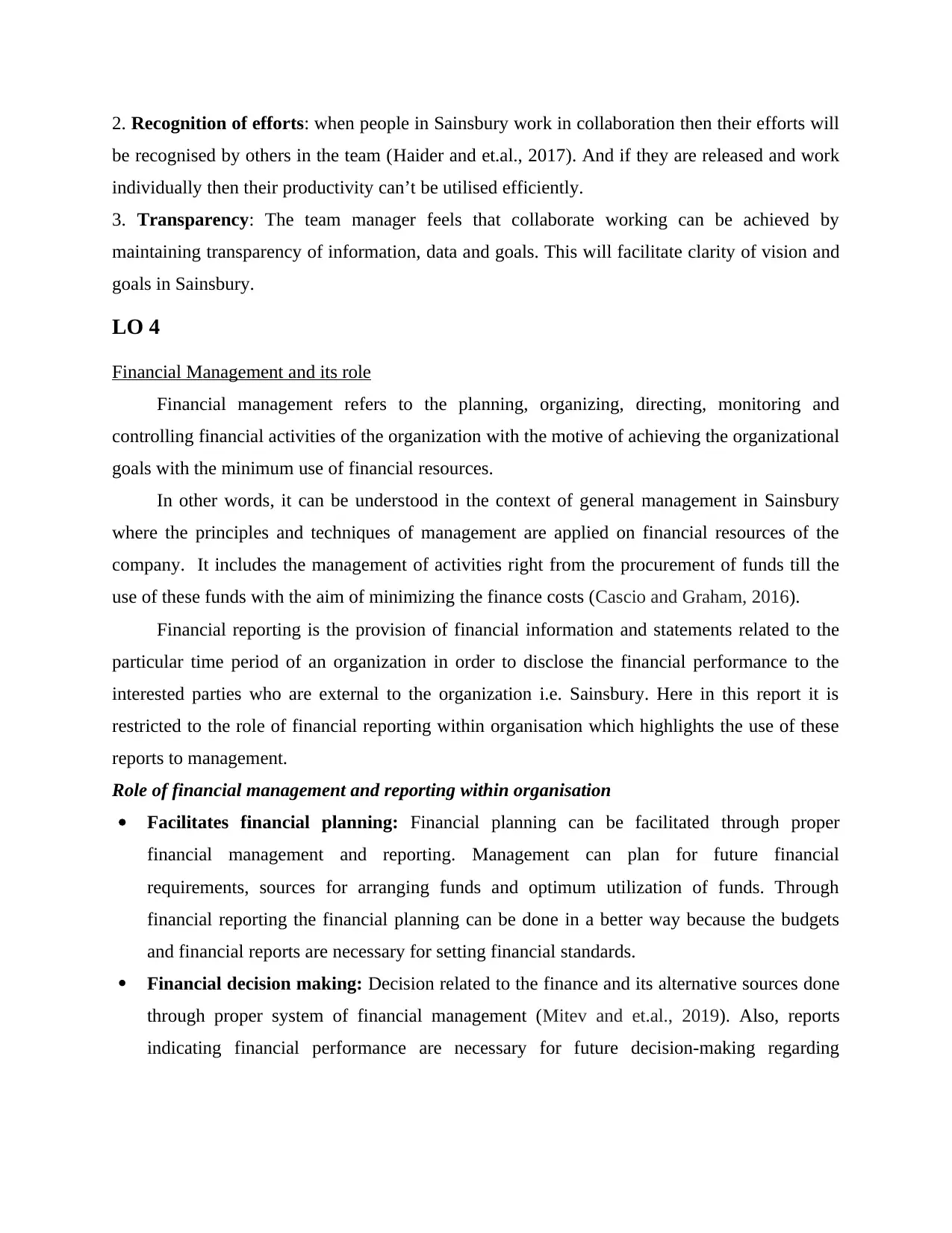
2. Recognition of efforts: when people in Sainsbury work in collaboration then their efforts will
be recognised by others in the team (Haider and et.al., 2017). And if they are released and work
individually then their productivity can’t be utilised efficiently.
3. Transparency: The team manager feels that collaborate working can be achieved by
maintaining transparency of information, data and goals. This will facilitate clarity of vision and
goals in Sainsbury.
LO 4
Financial Management and its role
Financial management refers to the planning, organizing, directing, monitoring and
controlling financial activities of the organization with the motive of achieving the organizational
goals with the minimum use of financial resources.
In other words, it can be understood in the context of general management in Sainsbury
where the principles and techniques of management are applied on financial resources of the
company. It includes the management of activities right from the procurement of funds till the
use of these funds with the aim of minimizing the finance costs (Cascio and Graham, 2016).
Financial reporting is the provision of financial information and statements related to the
particular time period of an organization in order to disclose the financial performance to the
interested parties who are external to the organization i.e. Sainsbury. Here in this report it is
restricted to the role of financial reporting within organisation which highlights the use of these
reports to management.
Role of financial management and reporting within organisation
Facilitates financial planning: Financial planning can be facilitated through proper
financial management and reporting. Management can plan for future financial
requirements, sources for arranging funds and optimum utilization of funds. Through
financial reporting the financial planning can be done in a better way because the budgets
and financial reports are necessary for setting financial standards.
Financial decision making: Decision related to the finance and its alternative sources done
through proper system of financial management (Mitev and et.al., 2019). Also, reports
indicating financial performance are necessary for future decision-making regarding
be recognised by others in the team (Haider and et.al., 2017). And if they are released and work
individually then their productivity can’t be utilised efficiently.
3. Transparency: The team manager feels that collaborate working can be achieved by
maintaining transparency of information, data and goals. This will facilitate clarity of vision and
goals in Sainsbury.
LO 4
Financial Management and its role
Financial management refers to the planning, organizing, directing, monitoring and
controlling financial activities of the organization with the motive of achieving the organizational
goals with the minimum use of financial resources.
In other words, it can be understood in the context of general management in Sainsbury
where the principles and techniques of management are applied on financial resources of the
company. It includes the management of activities right from the procurement of funds till the
use of these funds with the aim of minimizing the finance costs (Cascio and Graham, 2016).
Financial reporting is the provision of financial information and statements related to the
particular time period of an organization in order to disclose the financial performance to the
interested parties who are external to the organization i.e. Sainsbury. Here in this report it is
restricted to the role of financial reporting within organisation which highlights the use of these
reports to management.
Role of financial management and reporting within organisation
Facilitates financial planning: Financial planning can be facilitated through proper
financial management and reporting. Management can plan for future financial
requirements, sources for arranging funds and optimum utilization of funds. Through
financial reporting the financial planning can be done in a better way because the budgets
and financial reports are necessary for setting financial standards.
Financial decision making: Decision related to the finance and its alternative sources done
through proper system of financial management (Mitev and et.al., 2019). Also, reports
indicating financial performance are necessary for future decision-making regarding
⊘ This is a preview!⊘
Do you want full access?
Subscribe today to unlock all pages.

Trusted by 1+ million students worldwide
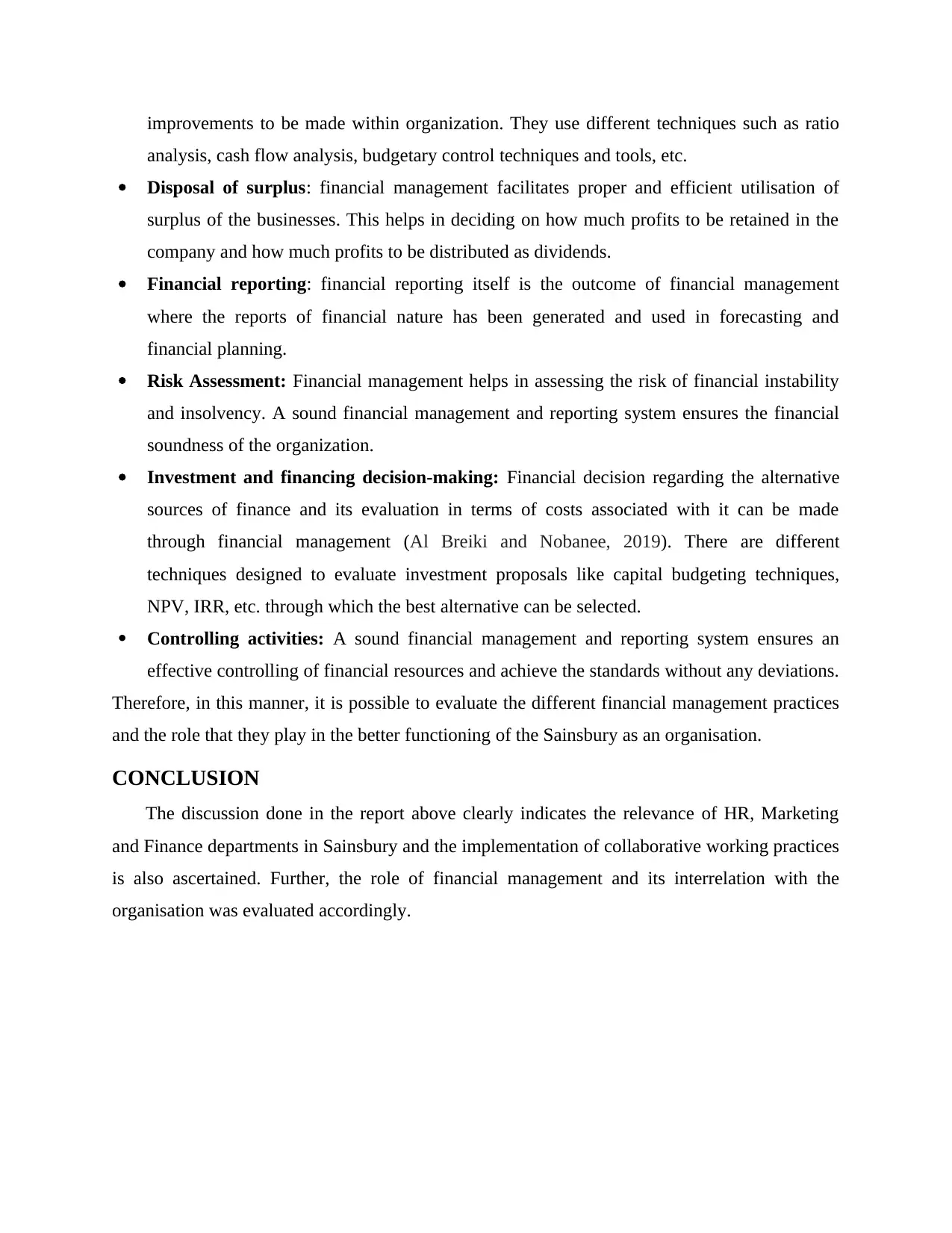
improvements to be made within organization. They use different techniques such as ratio
analysis, cash flow analysis, budgetary control techniques and tools, etc.
Disposal of surplus: financial management facilitates proper and efficient utilisation of
surplus of the businesses. This helps in deciding on how much profits to be retained in the
company and how much profits to be distributed as dividends.
Financial reporting: financial reporting itself is the outcome of financial management
where the reports of financial nature has been generated and used in forecasting and
financial planning.
Risk Assessment: Financial management helps in assessing the risk of financial instability
and insolvency. A sound financial management and reporting system ensures the financial
soundness of the organization.
Investment and financing decision-making: Financial decision regarding the alternative
sources of finance and its evaluation in terms of costs associated with it can be made
through financial management (Al Breiki and Nobanee, 2019). There are different
techniques designed to evaluate investment proposals like capital budgeting techniques,
NPV, IRR, etc. through which the best alternative can be selected.
Controlling activities: A sound financial management and reporting system ensures an
effective controlling of financial resources and achieve the standards without any deviations.
Therefore, in this manner, it is possible to evaluate the different financial management practices
and the role that they play in the better functioning of the Sainsbury as an organisation.
CONCLUSION
The discussion done in the report above clearly indicates the relevance of HR, Marketing
and Finance departments in Sainsbury and the implementation of collaborative working practices
is also ascertained. Further, the role of financial management and its interrelation with the
organisation was evaluated accordingly.
analysis, cash flow analysis, budgetary control techniques and tools, etc.
Disposal of surplus: financial management facilitates proper and efficient utilisation of
surplus of the businesses. This helps in deciding on how much profits to be retained in the
company and how much profits to be distributed as dividends.
Financial reporting: financial reporting itself is the outcome of financial management
where the reports of financial nature has been generated and used in forecasting and
financial planning.
Risk Assessment: Financial management helps in assessing the risk of financial instability
and insolvency. A sound financial management and reporting system ensures the financial
soundness of the organization.
Investment and financing decision-making: Financial decision regarding the alternative
sources of finance and its evaluation in terms of costs associated with it can be made
through financial management (Al Breiki and Nobanee, 2019). There are different
techniques designed to evaluate investment proposals like capital budgeting techniques,
NPV, IRR, etc. through which the best alternative can be selected.
Controlling activities: A sound financial management and reporting system ensures an
effective controlling of financial resources and achieve the standards without any deviations.
Therefore, in this manner, it is possible to evaluate the different financial management practices
and the role that they play in the better functioning of the Sainsbury as an organisation.
CONCLUSION
The discussion done in the report above clearly indicates the relevance of HR, Marketing
and Finance departments in Sainsbury and the implementation of collaborative working practices
is also ascertained. Further, the role of financial management and its interrelation with the
organisation was evaluated accordingly.
Paraphrase This Document
Need a fresh take? Get an instant paraphrase of this document with our AI Paraphraser
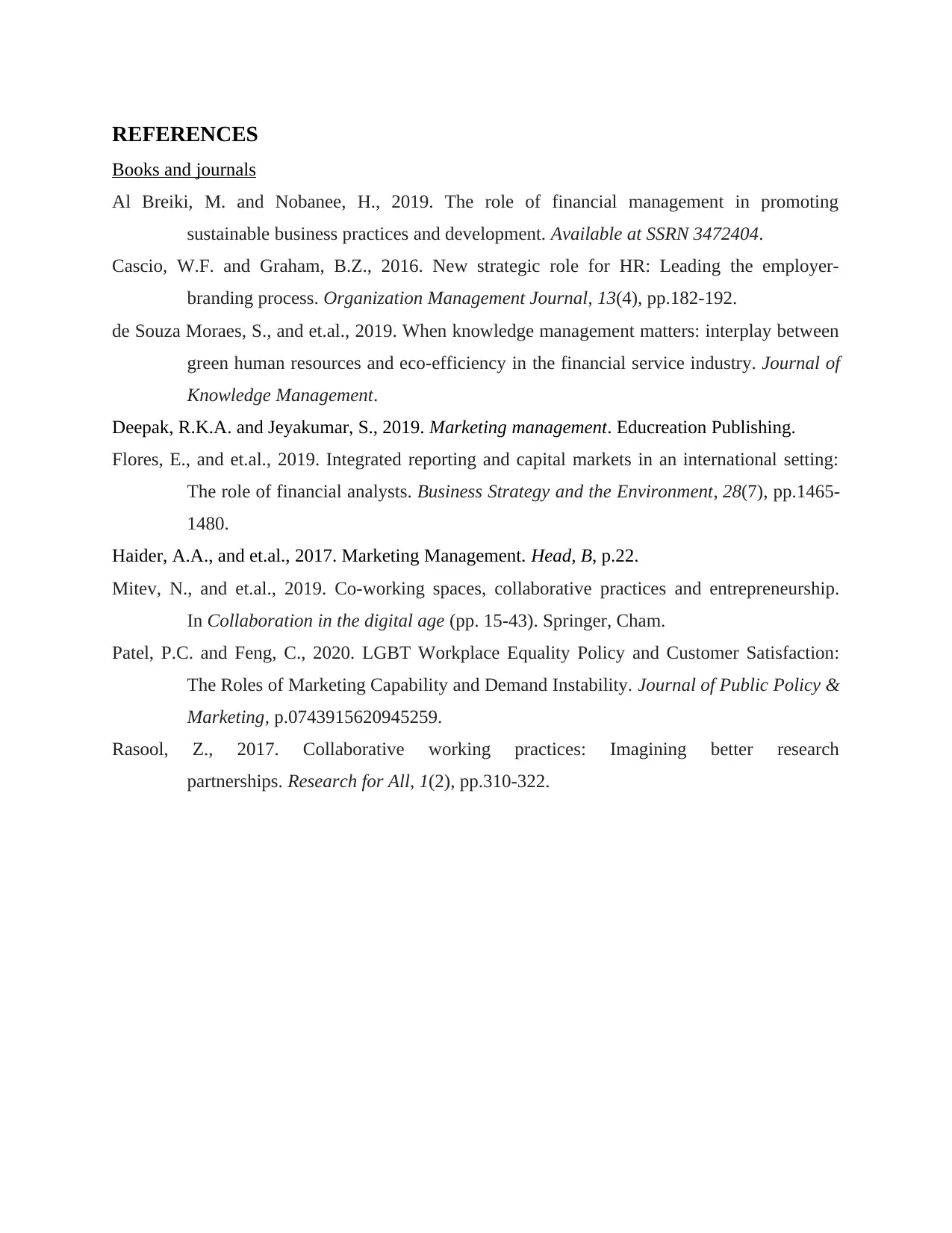
REFERENCES
Books and journals
Al Breiki, M. and Nobanee, H., 2019. The role of financial management in promoting
sustainable business practices and development. Available at SSRN 3472404.
Cascio, W.F. and Graham, B.Z., 2016. New strategic role for HR: Leading the employer-
branding process. Organization Management Journal, 13(4), pp.182-192.
de Souza Moraes, S., and et.al., 2019. When knowledge management matters: interplay between
green human resources and eco-efficiency in the financial service industry. Journal of
Knowledge Management.
Deepak, R.K.A. and Jeyakumar, S., 2019. Marketing management. Educreation Publishing.
Flores, E., and et.al., 2019. Integrated reporting and capital markets in an international setting:
The role of financial analysts. Business Strategy and the Environment, 28(7), pp.1465-
1480.
Haider, A.A., and et.al., 2017. Marketing Management. Head, B, p.22.
Mitev, N., and et.al., 2019. Co-working spaces, collaborative practices and entrepreneurship.
In Collaboration in the digital age (pp. 15-43). Springer, Cham.
Patel, P.C. and Feng, C., 2020. LGBT Workplace Equality Policy and Customer Satisfaction:
The Roles of Marketing Capability and Demand Instability. Journal of Public Policy &
Marketing, p.0743915620945259.
Rasool, Z., 2017. Collaborative working practices: Imagining better research
partnerships. Research for All, 1(2), pp.310-322.
Books and journals
Al Breiki, M. and Nobanee, H., 2019. The role of financial management in promoting
sustainable business practices and development. Available at SSRN 3472404.
Cascio, W.F. and Graham, B.Z., 2016. New strategic role for HR: Leading the employer-
branding process. Organization Management Journal, 13(4), pp.182-192.
de Souza Moraes, S., and et.al., 2019. When knowledge management matters: interplay between
green human resources and eco-efficiency in the financial service industry. Journal of
Knowledge Management.
Deepak, R.K.A. and Jeyakumar, S., 2019. Marketing management. Educreation Publishing.
Flores, E., and et.al., 2019. Integrated reporting and capital markets in an international setting:
The role of financial analysts. Business Strategy and the Environment, 28(7), pp.1465-
1480.
Haider, A.A., and et.al., 2017. Marketing Management. Head, B, p.22.
Mitev, N., and et.al., 2019. Co-working spaces, collaborative practices and entrepreneurship.
In Collaboration in the digital age (pp. 15-43). Springer, Cham.
Patel, P.C. and Feng, C., 2020. LGBT Workplace Equality Policy and Customer Satisfaction:
The Roles of Marketing Capability and Demand Instability. Journal of Public Policy &
Marketing, p.0743915620945259.
Rasool, Z., 2017. Collaborative working practices: Imagining better research
partnerships. Research for All, 1(2), pp.310-322.
1 out of 8
Related Documents
Your All-in-One AI-Powered Toolkit for Academic Success.
+13062052269
info@desklib.com
Available 24*7 on WhatsApp / Email
![[object Object]](/_next/static/media/star-bottom.7253800d.svg)
Unlock your academic potential
Copyright © 2020–2025 A2Z Services. All Rights Reserved. Developed and managed by ZUCOL.




